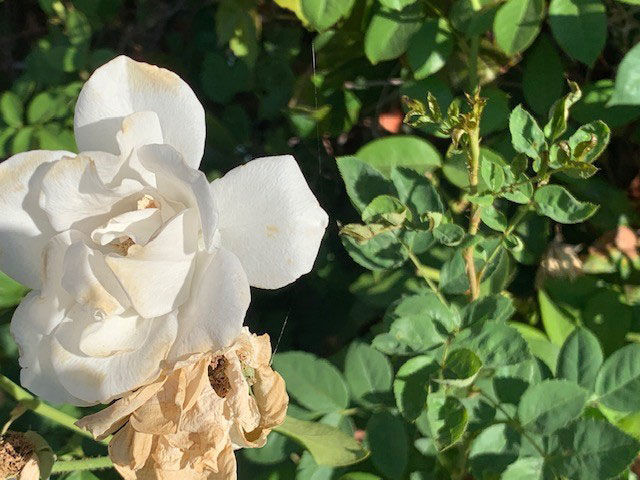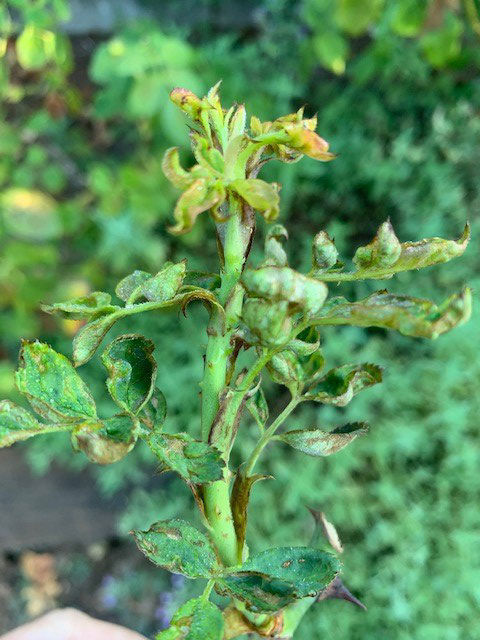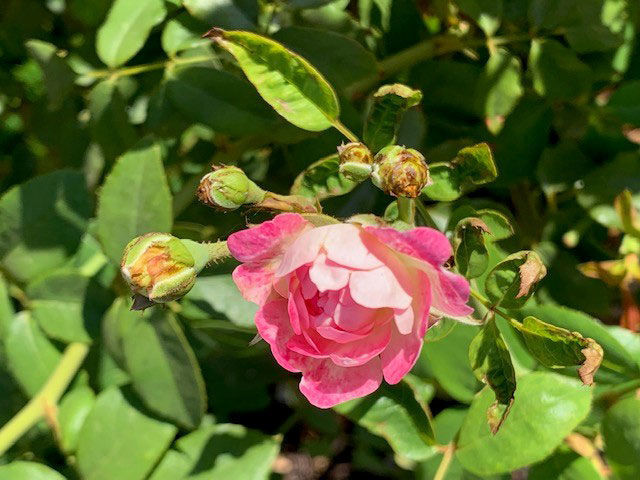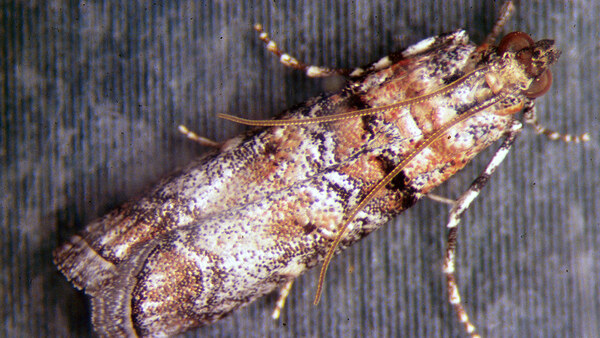
of chilli thrip presence. Photo: courtesy of Linda McKendry Design
The chilli thrip (Scirtothrips dorsalis) has become a serious problem in Southern California. This is a small insect native to Southeast Asia that has made its way to the United States, first appearing in Florida and Texas. Although it is quite mobile—able to fly up to 60 feet on a wind current—it has most likely been brought in on plants. Chilli thrips attack more than 150 species of plants, but one of their favorite plants to feed on are roses (Rosa spp. and cvs., Zones 3–9). This is because they prefer new growth, which roses are continually producing.
You may be more familiar with the western flower thrips (Frankliniella occidentalis). The chilli thrips are only about a third of the size but are even more deadly. They have piercing, razorlike mouthparts that cut open and suck the life out of plant material.
To get more information, I spoke to local expert Tom Carruth, E. L. & Ruth B. Shannon Curator, Rose Collections, at the Huntington Library, Art Museum, and Botanical Gardens in San Marino, California, a suburb of Pasadena. Carruth’s first reports of chilli thrips sightings were from gardeners in the San Fernando Valley in 2014, and by September 2015 they had moved into Pasadena. They are heat-loving insects that are not interested in traveling anywhere cold or freezing. Their activity is generated by extreme heat, specifically triple-digit temperatures.

Since the Huntington has a spectacular (and legendary) three-acre rose garden, its caretakers must be especially vigilant and proactive in their approach. Carruth’s attack strategy is multipronged. He and his team have brought in natural predators in the form of minute pirate bugs (Orius insidiosus) and lacewings. They have added beneficial fungi and nematodes to the soil to affect the larvae. They also have a program of spraying organic insecticides, keeping track of the weather, and spraying right before a heat wave.
Since the thrips are so small, you will most likely not see them in your own garden, but be on the lookout for the signs of their activity: crinkled and deformed leaves, leaves rolling upward, browning on the canes, and browning or discoloration on buds and flowers.

I also spoke to fellow landscape designer Linda McKendry of Linda McKendry Design, who specializes in rose care. McKendry says that if you find signs of infestation, “you cannot ignore it.” You should immediately cut off any affected blooms, buds, or leaves and bag them, tying the bag tightly before throwing it in the trash. Look for any plant material that has fallen to the ground, and dispose of that in the same way. Be sure not to put any of this material in your compost pile.
Spraying with an organic insecticide is beneficial as well. You do not have to spray the entire plant—just concentrate on the new growth. Neem oil and a spinosad such as Captain Jack’s or Monterey Garden Insect Spray are some products you can find readily in your local garden center. You can repeat the spraying once a week until symptoms disappear and/or the weather cools in the fall. I recommend spraying at least three times, alternating between the neem and the spinosad. There are other types of sprays available, but I am an organic kind of gal and so will only recommend those, as do Carruth and McKendry.
So, gardeners, do not despair over these thrips. Just remember when you stop to smell the roses to check for thrips and take them seriously.
Francesca Corra, APLD, is a nationally certified landscape designer and owner of Dirt Diva Designs in Studio City, California.


















Comments
Log in or create an account to post a comment.
Sign up Log in